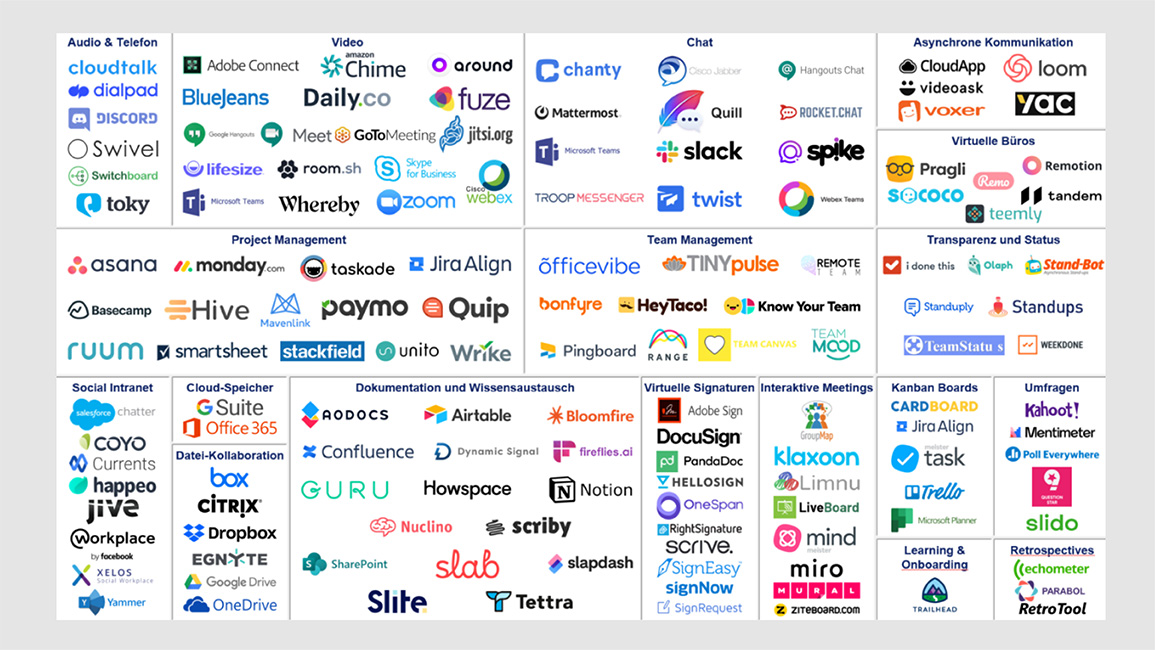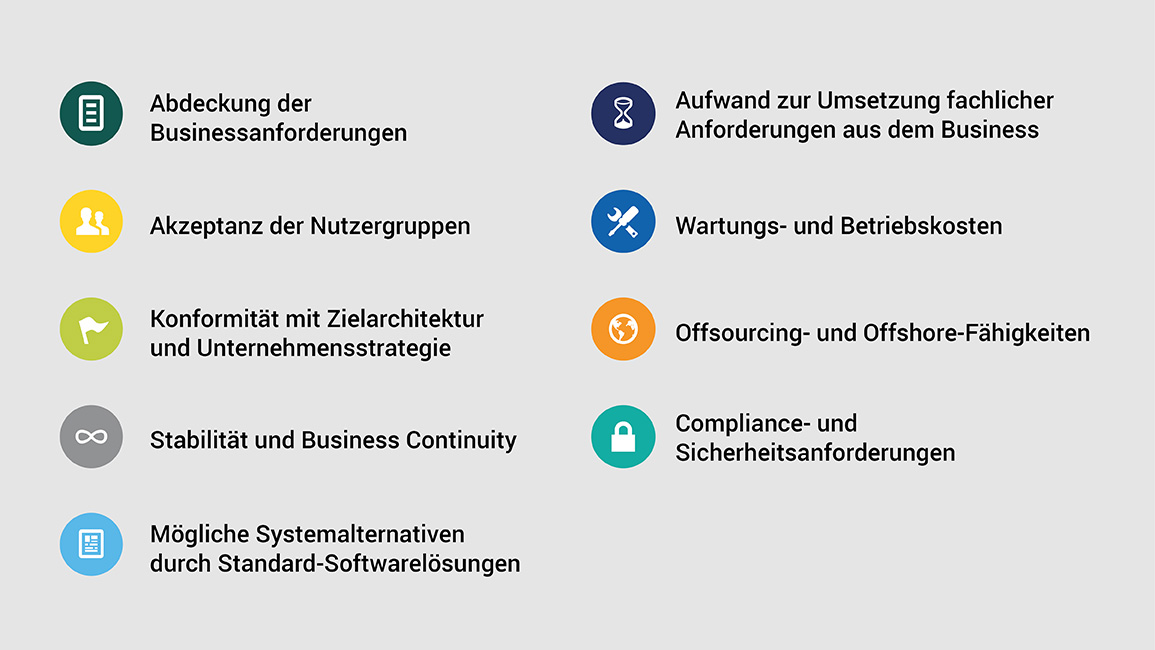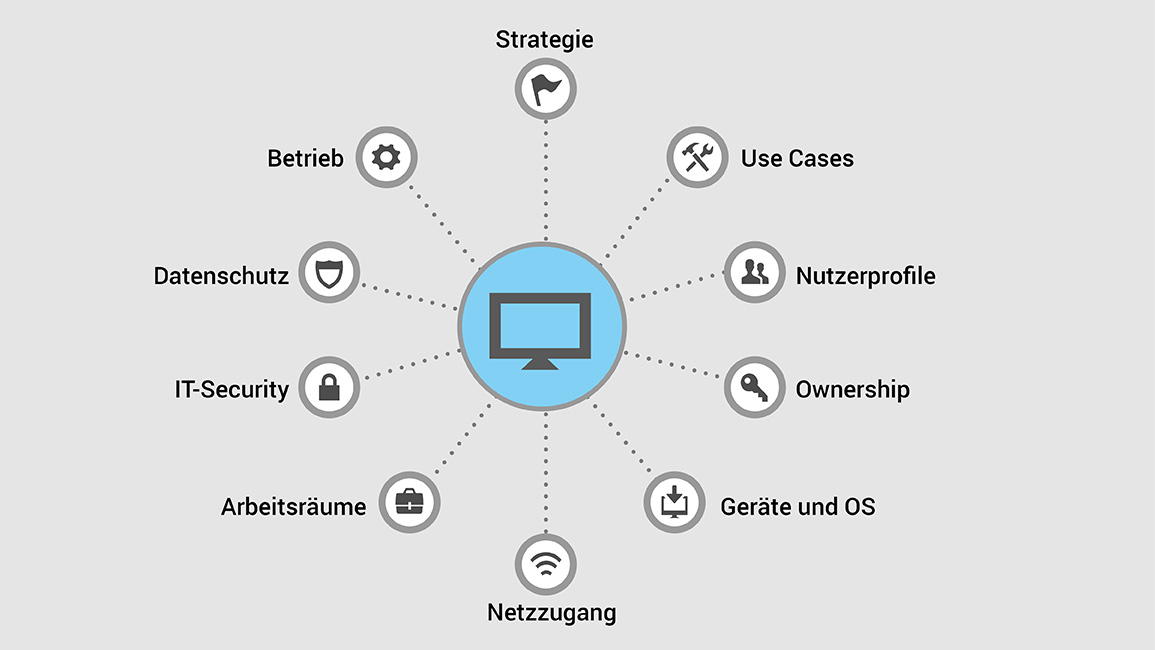The first easings after the Corona lockdown lets us breathe again, relief spreads. Nevertheless, we should prepare ourselves for the fact that the effects of Covid-19 will be with us for a long time to come. The pandemic has drastically changed, and will continue to change, our lives, our workplaces, and our social interactions. There will be no going back to the world before Covid-19.
And suddenly we were digital
Covid-19 revealed the state of digitalization in our society. Digitalization at the beginning of the 21st century should look different. Many of us experienced it not only at work, but also in our families: digital education in Germany was only possible in rudimentary form. And by no means all companies were able to follow the dictates of social distancing and switch to collaborative digital working overnight? But many very quickly outgrew themselves and provided their employees with an infrastructure that made working in a home office possible in a very short time. A virus as an accelerator of digitalization, albeit often improvised at first.
The question now is: How can the digital collaboration forced by Covid-19 be transferred from the stage of initial improvisation to a professional way of working with the right mix of IT tools?
This article takes an in-depth look at the issues critical to success when implementing and using collaboration tools. You will learn:
- How individual tools can be classified in the tool landscape of digital collaboration
- how company-specific requirements are to be placed on a collaborative IT tool
- How to organize and carry out a transparent and fact-based selection process
- what questions of IT security and data protection need to be answered, and finally
- what organizational and social challenges are associated with the use of collaboration tools and how these challenges can be overcome.
Every Crisis is an Opportunity - this one is a Catalyst
In Covid-19, we see a catalyst for the accelerated adoption of digital collaboration in business, in public administration, in our educational institutions, from primary to higher education, and in private life. In the short term, this is reflected in the implementation of new IT technical solutions; in the medium and long term, we see a powerful economic as well as societal trend towards virtualization of service delivery. These are just a few examples of the increasing importance of IT-based collaboration:
- Service provision in virtual networks, in which an increasing number of independent players join forces in ever new constellations for a specific order.
- Innovations that are no longer created within a company, but through cooperation at the most diverse levels of the value chain
- Spatial decoupling of work and home locations, saving travel time, air pollutants and energy
- Attractive employer brands act sustainably and protect the environment. This corresponds to the need to be able to provide services as flexibly as possible, independent of space and time.
Finding and implementing the right IT tools in a rapidly growing and confusing market is a major challenge, but not the only one. The challenges posed by remote work in terms of work psychology must also be successfully addressed. Social isolation of employees is just one facet, onboarding new employees another.
1. Tools as Enablers for successful Digital Collaboration
Effective and efficient collaboration design can span multiple areas of the organization and involve different application domains. Various categories of tool families have established themselves in the market, some of which have evolved from specific use cases.
The large number of providers and solutions often makes it difficult to clearly delineate the range of functions and applications (see Figure 1). Roughly speaking, the solutions can be divided into the areas of project and portfolio management, knowledge management, and video conferencing & instant messaging.
Project and Portfolio Management
In project and portfolio management, use cases are mainly found that serve the areas of task control, risk management, information and communication, and project reporting. Mostly, tools can satisfy both lean-agile-collobarative and traditional-classical team members.
For example, users can view the Kanban-style status view to visualize project progress and individual task statuses. Business goals and OKRs (Objectives and Key Results) can be defined to help with focus. Certain applications also offer sprint management capabilities including integration with Atlassian's Jira to meet the requirements of agile project management. In addition, features such as milestone planning using Gantt charts, generating reports for reporting, and time tracking are often provided to ensure direct invoicing.
Gartner cites Asana, Monday.com, ONEPOINT Projects, Planview and Teamwork Projects, for example, as leading vendors in the project and portfolio management application area.
Knowledge Management
Many teams that collaborate remotely also make use of tools that map knowledge base functions and promote collaboration within them. In this way, information and knowledge are managed, with employees not only receiving information, but also acting as an active part in knowledge management.
Many wikis allow quick editing of content directly on the page. Often, the option is offered to manage the permission to edit and view this content, so that work statuses do not have to be shared directly with the entire community. Most providers also build in features reminiscent of a social network. Team members can be mentioned to draw their attention to an article, for example, and work statuses and entire pages can be commented on and liked. Content that is considered interesting can be subscribed to, favorited and shared. The own profile can be completed and the possibility to display personalized content can be used. Thus, overview pages can be displayed individualized for one's own location and the specified role.
Most of the use cases described are found in BlueSpice, Atlassian's Confluence, DrupalWiki, and Foswiki, among others, which were developed specifically for enterprise use.
Videoconferencing & Instant-Messaging
To enable successful collaboration between team members who are separated from each other in terms of location, the provision of video conferencing and chat tools is indispensable. They ensure simultaneous but location-independent communication. With Covid-19, this area of application has become increasingly important. Some providers therefore also made their services available free of charge.
Use cases include holding video conferences and simultaneous desktop sharing, the ability to hand over control, and using a chat function. The control handover feature allows other participants to navigate through the desktop shared for control. This case is especially useful for service desk employees. Often group chats, i.e. adding several people to a chat, can be set up so that both intra-team and inter-team exchanges are possible via the chat function. Since this communication happens faster than via e-mail, some providers see their mission in replacing e-mail traffic in the long term. This is where the integration of other applications can be very useful. For example, team members are notified directly via the respective chats when a new comment is added in the Jira ticketing system, the company is mentioned via social media channels, or a new customer inquiry is received in the CRM (Customer Relationship Management) tool.
Solutions in this area include Cisco Webex, Google Hangouts, Microsoft Teams, Slack and Zoom.

2. Find the right solution with the help of Application Lifecycle Management
The multitude of tools and different functions offers many different possibilities, but also makes it difficult to keep track of everything. Another challenge is finding the right application for your own workforce among all the offerings.
New and updated requirements necessitate an assessment of the existing IT landscape and thus also an evaluation of the digital tools for collaboration between employees, customers and partners: To what extent can our daily business be mapped digitally? Can our IT landscape meet the changing requirements for digital collaboration?
The prerequisite for implementing new collaboration tools is that the business model and the business purpose permit the possibility of digital collaboration. In the field of education, first and foremost daycare centers, one will probably not benefit from such an application, or only in a small subarea. Thus, a distinction must also be made between the user groups themselves. Of course, the requirements of an employee in the field differ from those of a computer scientist. Ultimately, it is not a matter of finding the "best" tool, but rather of finding the applications that fit the existing IT, one's own company and the respective user group.
Application Lifecycle Management (ALM) helps to meet this mammoth task.
Every application in a corporate context often represents a not inconsiderable investment whose introduction, use and also replacement (retirement) must be managed very carefully. The various stages of an application or an application landscape made up of individual applications are depicted as an infinite spinning top in the context of application lifecycle management.
One of the principles of application lifecycle management is to always view the use of applications in companies as a temporary state. Temporary because the use cases, the technology and the framework conditions (see Covid-19) change continuously. An application or a group of applications must therefore always be checked to ensure that it fits the requirements and the application landscape must be further developed. This process of continuous review and further development of the application landscape is known as application lifecycle management.
In the context of digital collaboration, specific questions need to be asked of application lifecycle management, as this creates a particular area of conflict between user experience, information security and potential costs. Information security in particular has recently come under increased scrutiny due to a large number of successful cyber attacks on companies.
Creating Transparency with the ALM Check
An ALM check can provide very targeted transparency about the performance of IT applications and identify the most urgent need for action. The check follows the core questions of the application managers in a structured and step-by-step manner:
- Which of my applications support the strategic direction of the company and my IT strategy and are future-proof, and which are not?
- How can I implement the requirements of users and departments more quickly and flexibly at lower cost?
- Are IT operations and maintenance of my applications competitive or too expensive?
- Where do I invest before the trend of continuously decreasing IT budgets in order to generate maximum benefits of IT for the user?
- Do my applications meet the requirements for IT security and compliance as well as legal requirements (e.g. DSGVO)?
These core questions can be answered using selected evaluation criteria:

Results from the ALM check for the application landscape include:
- Transparency about the current state and the performance of IT applications in the context of digital collaboration
- Assessment of the maturity level of existing applications as a decision-making basis for controlling investments
- Identified weak points, prioritized according to urgency of implementation and value contribution
- Outlook for target development based on application clusters (building blocks)
- Identification of suitable follow-up measures to optimize the application landscape for subsequent phases
For the analysis of possible collaboration tools, the 10 dimensions of digital collaboration can be used as a supplement. This approach includes organizational and technical aspects to be considered, which together offer a 360° view of the requirements for the application landscape.

The check is thus an assessment of the performance of the As Is application landscape, forms the basis for clear and concrete recommendations for action that can be implemented, and is the basis for professionalizing and continuing application lifecycle management.
Possible measures can be, for example, the introduction or replacement of a tool, but also an improved integration of existing applications into the IT landscape (e.g., single sign-on). As part of an optimization measure to eliminate the identified weaknesses, new tools can be analyzed and evaluated using the same evaluation criteria. During the selection process, it is expedient to involve all relevant stakeholders in the company.
Important for Implementation: Involve relevant Experts at an early Stage
While the involvement of social partners is essential, it is recommended to bring IT security and data protection experts on board at an early stage in addition to the users. Especially in the case of new "fancy" tools, the need on the business side is usually very urgent and strong. This can lead to early decisions in tool selection that have to be revised later in the course of the project because there is no willingness to accept the associated risks or to assume the costs for necessary, sometimes function-restricting security solutions. Cloud-based tools in particular are sometimes not compatible with current security requirements or can only be implemented by means of costly additional measures (such as separate encryption gateways). Furthermore, the tools should also be evaluated in terms of integration with existing security systems (e.g., mobile device management, identity and access management, SIEM systems, etc.) to enable secure and smooth operation. On the other hand, IT security is also a big driver for application lifecycle management. Reducing the number of systems and applications and standardizing the architecture offers potential to reduce the attack surface for attackers. In addition, an application portfolio that covers business and user requirements very well also prevents the use of shadow IT, which is sometimes used completely separately from the company and IT operations (e.g., the use of cloud-based collaboration solutions via private accounts).
Particularly when introducing new tools, a holistic change concept must be considered in order to accompany users on their way to the new digital collaboration. This often goes beyond user training.
3. Why the social Component plays a decisive Role
Of course, digital tools are the key to efficient communication - especially in change and crisis situations. But there are a few things to keep in mind when using them to ensure that communication and virtual collaboration are clear and targeted. These points are clear to everyone, but mistakes are often made that lead to lack of transparency and uncertainty in use. One example is e-mail flooding via distribution lists: This is where the discrepancy lies between the actual forwarding of information to all employees involved and the targeted forwarding of information to the workforce.
Communicate purposefully in change and crisis Situations
A high and important asset is the basis of trust between management and employees. This is put to the test in critical situations anyway, as speculation about presumably planned measures quickly arises. It is certainly not possible to prevent this entirely, but prompt, open communication fosters trust - especially if management also shows up in person (e.g., virtual town hall meeting). It has proven effective to report regularly and transparently on the status in the organization. If available, tools for interactive communication and discourse should be used, for example via a social intranet. In this way, employees can be reached quickly and easily.
Social Dimension: "Space" is needed
Of course, the employer's premises are part of everyday working life for the overwhelming majority of employees - not least the double meaning of the word workplace describes this very well. What impact it has when this is eliminated for weeks, even months, is only felt by many people when one no longer has access. Even employees who were happy to have a home office day now and then miss the social contact with colleagues and feel "the power of the coffee machine", where even chance encounters with colleagues have an important function: People meet, they exchange ideas - not only about work-related topics, but also about how the weekend went. It's certainly possible to exaggerate this, but the complete loss of "social lubricant" is not only sorely missed by many employees. Managers who no longer see their employees and cannot assess how busy or overworked they are also want these informal encounters. Lounges, tea kitchens and corridors are currently not available - virtual rooms are needed: a virtual coffee break, the rededication of the daily standup to a video conference are possibilities that need to be used more!
The Manager and his/her even stronger Role as a Value Communicator
Beyond the mere function of keeping the store running, keeping the team together in times of crisis is also a crucial leadership task. Appointments like a virtual standup in the morning help strengthen the sense of togetherness. Too quickly, we all become digital nomads and feel like freelancers working for an anonymous client. Beyond the duty, this is the freestyle: transporting the cohesion, the team feeling into the virtual world. Values such as trust and openness can also be lived under the current framework conditions, but with the help of tools. Additional solutions are needed here to build trust between people virtually as well. However, this will continue to be a must-have in the future through physical interaction.
Meeting and Communication Etiquette becomes even more important
Some rules of the game change in the digital world, others remain as they are - you just have to pay more attention to them. For example, people who speak frequently and at length in conference calls miss the eye-rolling feedback from colleagues that they should be more concise for once. Here, rules of the game can be agreed upon in advance, to which colleagues can adhere and which can also be pointed out to them. All in all, the longer virtual meetings last and the more people take part in them, the more thoroughly they need to be prepared in order to be productive and effective.
Rituals can serve as the Key to Success
Some examples already mentioned are also suitable as rituals, such as a Virtual Coffeebreak. The word ritual sounds old-fashioned at first and not suitable for the 21st century. However, rituals have fulfilled an important function for many millennia: These recurring events have a familiar effect, provide stability and security. But they have to fit the team and the organization: The times should not disrupt the workflow, the participants should know each other personally, and the rituals should be charged with a meaning that is familiar to the participants.
You can find out more about "New Work after COVID-19" in our study of the same name with the subtitle "7 fields of action for your path to the new working world".
Summary
Covid-19 has forced many companies to rethink their digital strategy and redefine the business requirements that derive from it.
To evaluate these, the application lifecycle management approach suggests first analyzing the existing applications and thus creating transparency about the existing tool landscape. The next step is to evaluate these applications on the basis of specific criteria and to set priorities. It is particularly important to select evaluation criteria that are appropriate for the company, as these can vary greatly. With the help of this application evaluation, optimization potentials can now be determined and fields of action identified. The final step is to initiate the right measures on the basis of an optimization strategy and thus leverage the desired potential.
In principle, the established application portfolio must be regularly reviewed and adapted to changing business requirements and new technologies.
However, a coherent application portfolio will only be a success if it also takes into account the factors that understand the user as a socially active being. When introducing new tools, especially in the area of digital collaboration, attention must therefore be paid to a holistic picture that integrates technical and social components in equal measure.
A White Paper by Magdalena Hover, Jan Pfeifer, Volker Presse and Steffen Roos -
in cooperation with Lars Attmer, Joachim Lang and Andreas Närmann








